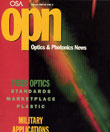
February 1998 Issue
- Developing Standards for the Optical Transport Network
- WDM and Optical Networks: Market Directions
- Plastic Optical Fiber: A Short-Haul Solution
- Military Laser Applications: Providing Focus to Nonlinear Optics R&D
- Laser Safety Standards and Fiber Optics: An Update
- Abbe's Sine Condition
- The OSA-Library Connection
- A Wide-Range 35 mm SLR Zoom
- Fun with CDs
- Browse all Issues
Feature Articles
Developing Standards for the Optical Transport Network
With the rapid expansion of fiber optic telecommunications, the need for prospective standardization is critical. The authors provide a current picture of where the international standardization effort stands and the challenges confronting those both defining and working within them.
by Laurel Clark and John EavesWDM and Optical Networks: Market Directions
The authors discuss WDM and its components, both in terms of future technology and markets.
by John P. Ryan and Mathew SteinbergPlastic Optical Fiber: A Short-Haul Solution
Plastic optical fiber is cheaper, more durable and flexible, and easier to install and maintain than more traditional data transmission materials. It is especially well suited to short distance applications, such as LANs, which require high-speed bandwidth.
by I. Edward BermanMilitary Laser Applications: Providing Focus to Nonlinear Optics R&D
Hopkins shares his view from the nonlinear optics R&D arena, looking at the military laser applications that drive and focus efforts in nonlinear optics.
by F. Kenneth HopkinsLaser Safety Standards and Fiber Optics: An Update
Forrest compares FDA and IEC standards and definitions for lasers and LEDs within fiber optic systems.
by Gary ForrestAbbe's Sine Condition
Ernst Abbe (1840-1905), professor of physics and mathematics at the University of Jena, Germany, and major partner in the Carl Zeiss company, made important contributions to the theory and practice of optical microscopy. His compound microscope is a superb optical design based on a theoretical understanding of diffraction and the minimization of the effects of aberrations. Abbe enunciated his famous sine condition with regard to the axial point in the object plane of a centered image-forming system, such as a microscope or a telescope. When this condition is satisfied, "aberration-free" imaging of the object points located in the vicinity of the optical axis is assured.
by Masud MansuripurThe OSA-Library Connection
Moving into new arenas is often a daunting proposition, so when OSA took its first steps into electronic publishing, the Society began to look for ways to ensure that its products would be marketable. One place OSA turned to was its Library Advisory Committee (LAC). Originally an ad hoc committee formed in 1993 to build firmer links to the science library community, the LAC evolved into a advisory body. The LAC consists of OSA members and senior librarians who represent academic, corporate, and laboratory libraries. Since LAC members have strong interests in electronic information and since the library community as a whole is one of OSA's financially critical customers, the Society asked LAC to provide input on the future dissemination of scientific information.
by Kathy NordausA Wide-Range 35 mm SLR Zoom
Zoom lenses with a focal length range of 28-200 mm have become very popular as an "all-in-one" lens for 35-mm SLR cameras. To date, this class of zoom lens is represented in U.S. literature by only a few, fairly recent patents. This month's design is an example of such a lens by Nikon, and is notable for its compactness and high image quality.
by J. Brian CaldwellFun with CDs
If you're looking for something to do with all those free Internet CDs that arrive almost daily in the mail, here are some fun, amusing, and inexpensive optics demonstrations that make use of these and other commonly found objects.
by Jennifer Turner-Valle

![A multiplexed image of a human tonsil acquired. [NIAID] using the iterative bleaching extends multiplexity (IBEX) method.](https://opnmedia.blob.core.windows.net/$web/opn/media/images/articles/2024/0424/departments/202404-cover-web.jpg?ext=.jpg)
